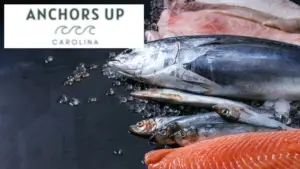Fresh fish is highly sought after around the world. For this reason, countless fish end up on the fillet table on a daily basis. While some fillet fish at marina fillet tables, others clean fish at home. I have utilized marinas and my house to cut fish. Once the flesh is removed, the question remains: What should you do with fish carcasses? When it’s time to dispose of a fish carcass, here is what you should do.
Fish Carcasses Make Excellent Bait
One of the best uses for a fish carcass is turning it into bait. Without question, everything from blue crabs to other fish will devour a carcass.
Unquestionably, if you’re going crabbing, particularly blue crab, don’t dispose of the carcasses. Instead, toss the carcasses in the bait holder of the trap. Carcasses tend to last longer when compared to chicken necks or small bait fish as a result of the density.
Secondly, connect the bait holder through the eyes if you’re using a ring net while crabbing. The scent and oils will draw crabs quickly into the net.
Third, carcasses make excellent bait for predators, including sharks. Hooking a filleted fish and sending it to the bottom or free-lining is sure to attract the attention of aggressive feeders.
Lastly, the remnants of the fish can be turned into chum. Instead of tossing the carcasses, grind them and freeze the ground chum in blocks to be used offshore when reef fishing.
Disposing Of Carcasses At A Marina Fillet Table
The marina fillet table is the easiest place to dispose of fish carcasses, especially in saltwater environments. Without question, crabs and fish will quickly pick the bones clean of any meat. However, in freshwater, you will not encounter as many aggressive feeders.
Follow a couple of easy steps to properly dispose of fish carcasses at marinas. First, before tossing the fish into the water, poke the eyes with the tip of the knife so they are punctured. Secondly, break the spine in half. These two simple steps will prevent the carcass from floating to the surface.
Importantly, toss carcasses out of sight from the fillet table in freshwater. Again, the number of predators is limited; therefore, the fish will sit in place until they decompose.
Disposing Of Fish Carcasses When Filleting At Home
I have often brought my fresh catch home to fillet rather than using the marina fillet table. The decision to bring them home is based on time. I chose to leave them on ice and cut the fish up later that day.
Without question, you have a couple of options regarding what to do with fish carcasses. Here is a breakdown of your options. However, it should be noted: don’t ever toss the carcasses in the garbage cans unless you’re a day from pickup. The fish, despite being well bagged, will stink and attract unwelcome critters, including raccoons and rats.
Use The Carcasses As Fertiziler
One of the best options for disposing of fish carcasses at home is utilizing them as fertilizer. The best method is grinding the carcasses. Ground-up fish carcasses can be spread across gardens or flower beds. However, grinding fish requires a substantial amount of work.
The second option is digging a deep hole to drop the fish carcasses before covering them with soil. The hole must be deep enough to prevent critters and birds from pulling them up and out of the ground for the next meal.
Return The Carcasses Back To The Water
Making the decision to return the carcasses back to the water is highly dependent on your location. An angler will unlikely drive back to the water to dump carcasses if the distance is long.
In the event you’re within close proximity to a marina, again, break the spine and poke the eyes before dumping them in the water. However, on your journey, ensure that the fish container will not spill. A spilled cooler or bucket will leave your vehicle with a long lasting unpleasant scent.
I personally prefer to toss my fish carcasses in saltwater lagoons scattered about my neighborhood. Again, the combination of fish and crabs causes the carcasses to decompose quickly.
Pick The Best Option For You When Disposing Fish Carcasses
Again, the goal is to prevent carcasses from remaining visible or smelling the unpleasant decomposing odor. The beauty of dealing with fish carcasses is the fact that you have a fresh seafood dinner. I limit the number of fish I keep per trip because I prefer to avoid freezing fillets. Therefore, I am not disposing of a large number of carcasses at a time.





